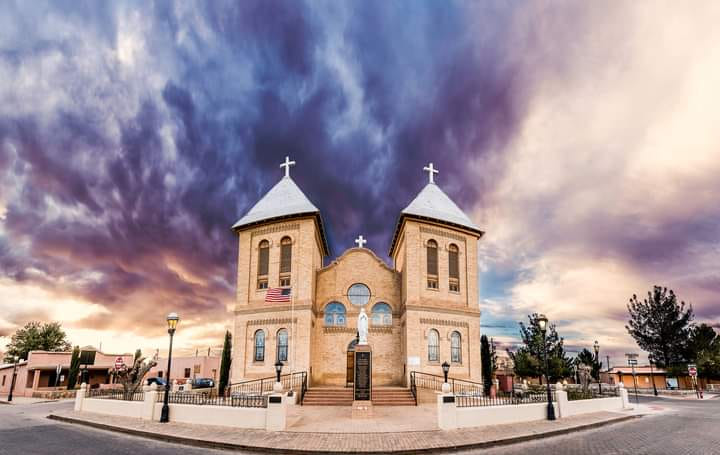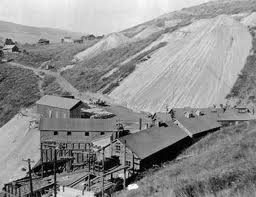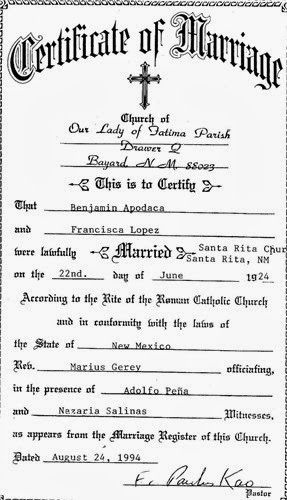Records indicate that mining began in Fierro around 1841. While working in a Mexican mine, a German immigrant noticed the high quality of copper coming from up north, and he went to check it. Attracted by the rich deposits of copper and iron, he started to mine on a mountain a few miles north of the Santa Rita mine. He named it Hanover mountain, after his home in Germany. There was enough copper to warrant a Confederate raid on the mine site during the War between the States. But there were natural limitations on the amount of ore that could be mined, war or not. The problem was getting the raw ore to a place of refining. At the time the closest spot was in Colorado.
For most of the nineteenth century Fierro could be described as a typical mining camp. In his book, "Black Range Tales," McKenna tells about stopping off at a saloon in Fierro for a drink. He also describes the method of incarceration used in mining towns, including Fierro. A big log was imbedded into the ground, with about eight feet exposed. The unlucky culprit who disturbed the peace was tied to the log until he sobered up or quieted down. Sometimes this could be overnight.
Late in the nineteenth century the railroad was extended to Silver City, and to the copper mines in Santa Rita. Now the ore had only to be carted a short distance. Around the turn of the century the railroad was extended to Fierro, and mining now experienced a tremendous growth. What the mines needed now was a source of cheap labor, and fortunately for them, this was close at hand.
Since gaining independence from Spain, Mexico had been experiencing severe civil unrest. An easy way for people to escape the suffering was to head north, where they knew that work was plentiful. And north they went. The Old World met the New World as many Mexicans joined the German enterprise and wound up in the iron mines of this small mining camp northeast of Silver City. They called it El Fierro, the Spanish word for iron. Fierro now grew from mining camp to mining town. Men with names like Niffen, Peoples, and North worked with newcomers with names like Arellanes, Loera, and Maldonado. Holidays like the Fourth of July and the Sixteenth of September were celebrated with equal gusto.
The Mexican population lived differently from the mining company staff. For instance, the latter had running water, flush toilets, and a golf course. But the memories many of us have are not of deprivation or prejudice, but the excitement of growing up in the midst of a boom town.
The Great Depression was the straw that broke the camel's back. Mining operations ceased in 1931, and were to remain dormant for many years, long enough for the town to die. All businesses, with the exception of a couple of grocery stores, were closed, and people started moving out. Fierro still existed during World War II, as many of its native sons went off to war. But time seemed to pass Fierro by, and there are now only a few hardy citizens living there.
But the past is still there, located in the ruins of buildings. Most of the streets are now overgrown with brush and trees. Both the church and, ironically, the cemetery, are vital and alive. Masses are offered at St. Anthony's every other week, and the feast of St. Anthony in June is a homecoming of sorts, as hundreds return to worship. The cemetery has also become a focal point for those who love Fierro. Many tombstones, long neglected, have been redecorated. The past can be read there as well. In one place four young men lie side by side; they died in a "short fuse" mine accident. There are other tombstones which tell of those who went to war and never returned, or who took sick and died unexpectedly.
 St. Anthony ChurchAnd just as Fierro was once a place where the Old World met the New, now it is a place where the Past meets the Future. Fierro is in the news again. After the mines closed and the people moved away, one mine - the Continental Mine - continued to work periodically. A few years ago the current operators, Cobre Mining Company, announced an extensive expansion plan that would have made the old-timers' eyes bug out. The Continental Mine was by now a large open pit. The cone-shaped Hanover Mountain at the north end of town was slated to be carved out, to become an open pit as well. Various other operations would be carried out in the townsite. The old way of life seemed to be returning.
St. Anthony ChurchAnd just as Fierro was once a place where the Old World met the New, now it is a place where the Past meets the Future. Fierro is in the news again. After the mines closed and the people moved away, one mine - the Continental Mine - continued to work periodically. A few years ago the current operators, Cobre Mining Company, announced an extensive expansion plan that would have made the old-timers' eyes bug out. The Continental Mine was by now a large open pit. The cone-shaped Hanover Mountain at the north end of town was slated to be carved out, to become an open pit as well. Various other operations would be carried out in the townsite. The old way of life seemed to be returning.But there was a great difference between one century and the other. Environmental legislation enacted since the days of the old mining operations required that the environmental impact of the mine be studied. The company had requirements to meet.
In addition, many former residents moved back into the area as they retired, and their children and their children's children took an interest in the place where their ancestors had come from. They became very concerned about the fate of the two important landmarks within the town, St. Anthony's, and the cemetery.
As a result the company has promised that neither of these two places will be disturbed. Local city governments have come out in favor of the proposed mining operations. It appears that everything will be settled to everybody's satisfaction, and the proposed operations will become a reality. Economically, everyone should benefit. In addition, the Fierro of memory has come alive again as well, and the interest of those who have come from what is now a ghost town will ensure that its memory will live on, both on the page and in the hearts who have come from there.
In addition, the Fierro of memory has come alive again as well, and the interest of those who have come from what is now a ghost town will ensure that its memory will live on, both on the page and in the hearts who have come from there.
















.jpg)



.jpg)


















